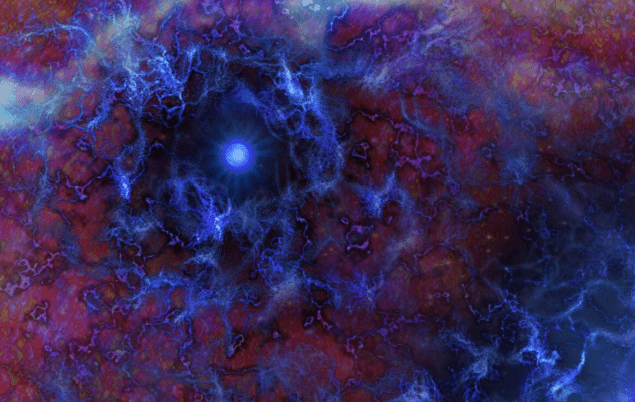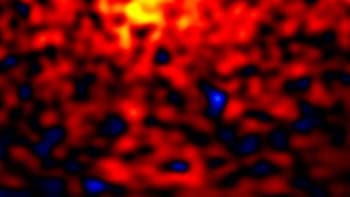
New research lends further support to the idea that a detection of surprisingly strong absorption by primordial hydrogen gas, reported earlier this year, could be evidence of dark matter. The new results, described in three papers in Physical Review Letters, are theoretical and do not settle the issue. Indeed, one group is sceptical of the dark-matter interpretation. But the work heightens interest in ongoing observations of the “cosmic dawn”, with new results from radio telescopes expected within the next year.
According to cosmologists, the hydrogen gas that existed in the very early universe was in thermal equilibrium with the cosmic microwave background (CMB), which meant that the gas would not have been visible either through absorption of the microwave photons or through emission. But at the start of the cosmic dawn about 100 million years after the Big Bang, ultraviolet light from the first stars would have excited the hydrogen atoms and shifted the distribution of electrons within the lower and upper levels of the hyperfine transition. As such, the hydrogen would have started to absorb much more radiation at the transition wavelength (21 cm), which would be seen today as a dip at longer, re-shifted wavelengths in the CMB spectrum.
The stakes are high because if the signal is real, this experiment is worth two Nobel prizes
Abraham Loeb
In February, researchers working on the Experiment to Detect the Global Epoch of Reionization Signature (EDGES) telescope reported in Nature that they had seen just such a dip at a wavelength of 380 cm in data from their small ground-based antenna system in Western Australia. The observation was exciting news, but nevertheless in line with standard cosmological theory. However, the dip was actually twice as deep as expected – immediately leading theorists to speculate that the hydrogen was in fact interacting with particles of dark matter.
“The stakes are high because if the signal is real, this experiment is worth two Nobel prizes,” says Abraham Loeb of Harvard University. “One for being first to detect the 21 cm signal from the cosmic dawn and the second for finding an unexpected level of hydrogen absorption that may be indicative of new physics.”
New or old force?
The idea is that the dark matter would have been colder than the hydrogen atoms and so interactions between the two would have transferred energy from the gas to the dark matter – so cooling the gas and boosting absorption. The possibility of this mechanism being tied to the switching on of the first stars was proposed by Rennan Barkana of Tel Aviv University in Israel, but Barkana suggested that the interaction could involve a new fundamental force between dark and ordinary matter.

Ancient hydrogen reveals clues to dark matter’s identity
However, Loeb and Harvard colleague Julián Muñoz argued that there could be no such force as it would have led to stars cooling more quickly than is observed. Instead, they reckon that the interaction could be that of familiar electromagnetism – requiring that a small fraction of dark matter particles have little mass and carry about a millionth of the charge of the electron.
That view has now won cautious backing from other researchers in the US. By imposing constraints from a wider range of cosmological and astrophysical observations, Asher Berlin of the SLAC National Accelerator Laboratory in California and colleagues have shown in a new paper that dark matter interactions could indeed explain the EDGES results if up to 2% of dark matter weighs in at less than a tenth the mass of the proton and has a charge less than 0.01% of the electron’s. Berlin and colleagues do, however, add that this scenario would require “additional forces” to subsequently deplete the dark matter so its abundance is in line with observations of the present universe. “Although it’s possible that dark matter could produce the EDGES result, it is not easy or simple to do so,” says Berlin’s colleague Dan Hooper of Fermilab near Chicago.
Extraordinary claims
Loeb acknowledges that “extraordinary claims require extraordinary evidence,” adding that the apparent 21 cm signal from EDGES could be nothing more than instrumental noise or absorption by dust grains in our galaxy. He looks forward to new results from other experiments operating at different sites – including SARAS-2, LEDA, and PRIzM – and expects new data to be available within the next year.
Even if the signal is confirmed, however, dark matter is not necessarily the culprit. Guido D’Amico and colleagues at CERN in Geneva argue in the second new paper that proponents of the dark-matter interpretation have carried out an “incomplete analysis” by neglecting the heating effect of dark-matter annihilation. In particular, they say that annihilations could inject electrons and low-energy photons into the hydrogen gas, thereby potentially heating the gas more than it is cooled. As such, they conclude, dark-matter annihilations are “strongly constrained” by a 21 cm signal.

Charged dark matter could explain chill in early universe
In a third new paper, on the other hand, Anastasia Fialkov of the Harvard-Smithsonian Center for Astrophysics in the US and colleagues (including Barkana) show that the dark-matter hypothesis yields an additional prediction that can be tested using different kinds of radio telescope. They have found that the 21 cm signal should vary across the sky by up to 30 times as much as it would do if there were no charged interactions between ordinary and dark matter – and pointing out that this prediction can be tested using low-frequency interferometers.
Muñoz is enthusiastic about these spatial measurements, explaining that they are far more immune to foreground noise and other potential systematic errors than the data collected by EDGES, and are therefore, he says, “more reliable”. He reckons that a couple of interferometers – LOFAR in the Netherlands and HERA in South Africa – might have gathered sufficient data within the next five to ten years to establish definitively whether or not the dip at 21 cm really is due to charged dark matter.



